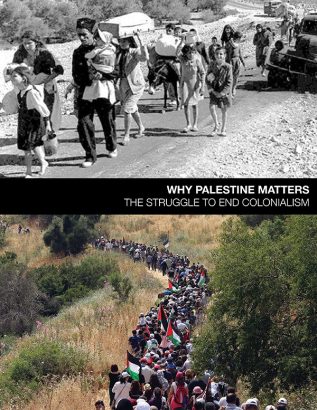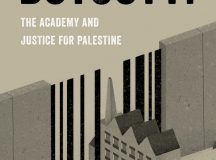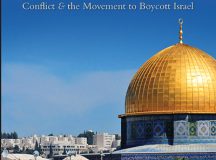The Presbyterian Church (USA) has published an ideological and political manual for anti-Israel organising ahead of its bi-annual gathering in June. Reviewing its content, Cary Nelson argues that the publisher’s claim to have produced ‘a study guide’ cannot be accepted. Rather, the language of ‘intersectionality’ is misused in a Church-sponsored demonisation of the Jewish state that is propelled by insinuation more than responsible argument. The controversial academic Steven Salaita argues that the phrase ‘Israeli hummus’ is not just an act of ‘cultural appropriation’ but ‘a promise of genocide’. Sarah Schulman slams Israel’s gay-friendly legal and cultural environment as ‘pink-washing’. Reconciliation and dialogue initiatives are trashed as ‘normalisation’. Israel is accused of ‘genocide’ and the conflict is said to have ‘parallels to the history of slavery in the United States’. The result is a glossy Church-sponsored prospectus for the abolition of the Jewish state that should deeply concern Presbyterians in America.
Toward the end of the Presbyterian anti-Zionist book, Why Palestine Matters: The Struggle to End Colonialism, a sequel to Zionism Unsettled issued in April 2018, just barely in time for PC(USA)’s bi-annual meeting in June, there is a decidedly improbable effort to extend the politics of intersectionality to include a link between Gaza and Puerto Rico. The second item in ‘Parallels with Puerto Rico’ is ‘Letter from Gaza: “We Are All Puerto Ricans,”’ which opens by declaring ‘I know what it’s like to struggle with shortages of vital supplies such as electricity, gas, cash, and safe water’ (82).
Why Palestine Matters is a 110-page oversized book consisting of 39 essays, over 30 breakout supplements, and a large number of illustrations with full paragraph captions. It includes three very useful colour maps, one each of Gaza, West Bank settlements, and West Bank Areas A, B, and C. The editors make an effort to describe it as the third ‘study guide’ issued by IPMN, the Israel/Palestine Mission Network of the Presbyterian Church (US), but it is so fiercely one-sided that it really serves exclusively as an ideological and political manual for anti-Israel organising. The volume breaks with IPMN’s history by explicitly aligning itself with the BDS movement and doing so at length. Many of the essays are new, but a few are excerpts from earlier publications. In the latter category are Steven Salaita’s unusually intense ‘Cultural Appropriation or Theft?’ which warns us that the phrase ‘Israeli hummus’ is a radical form of cultural appropriation, amounting to ‘a project of erasure, a portent of nonexistence, a promise of genocide’ (61) and Sarah Schulman’s ‘Rebranding with Sex and Sexuality,’ which reprises her 2011 brief against ‘pinkwashing,’ the purported effort to distract attention from the military occupation of the West Bank by highlighting Israel’s gay-friendly legal and cultural environment.
The book’s political stance is signaled at the outset not only by its subtitle but also by its foreword by Richard Falk, one of Israel’s most relentless long-term opponents. He concludes his assessment of Israel’s history and present prospects by insisting that ‘negotiation of a sustainable peace depends on the prior disavowal and abandonment of the apartheid regime that Israel relies upon to subjugate the Palestinian people’ and agreement ‘that any legitimate state or states that emerge in Palestine formally must be neither religious nor ethnic’ (8). A page earlier he had declared that ‘denying involuntary exiles a right to return to their native country is a grave violation of international refugee law’ (7). He envisions a full right of return for all descendants of the 1948 Arab refugees, 95 per cent of the original refugees themselves by now being deceased. If the result were to be a majority Arab state, any promise that it would be a securely secular entity would soon be forgotten. A home for the Jews it would not be.
The page devoted to Puerto Rico follows many pages devoted to more familiar ‘intersections,’ including that promoted by a segment of the Black Lives Matter movement. An Israeli Defense Force/Hurricane Maria parallel, notably, is pretty much a completely empty analogy. Neither the two instances of infrastructural devastation nor the human tragedies they accompanied really have anything to do with one another. An international relief effort could address urgent requirements in both places, but then what Puerto Rico needed was a serious full-scale commitment from the wealthiest country in the world, not international charity. I had expected the editors of Why Palestine Matters to base the case for the ‘intersection’ of Gaza City and San Juan on underlying racism as the common cause. That certainly goes a long way to explaining the Trump administration’s indifference to Puerto Rico’s plight, but it has little or nothing to do with the Netanyahu administration’s tragic and highly dangerous neglect of Gaza.
Why Palestine Matters appropriately places the 1901 US Supreme Court case Downes v. Bidwell at the root of the secondary status of the island, but that is not an adequate explanation of why Hurricane Maria did not provoke a new push for Puerto Rican statehood. The fact that the Island would vote reliably Democratic has more to do directly with a Republican Congress’s unwillingness to address its statehood status. All this is to say that the specifics of history and politics can get squarely in the way of promoting ‘intersections’ between injustices in different parts of the world. The editors are able to produce a charming photograph of three Puerto Rican women arm-in-arm with a Palestinian American San Francisco State University professor holding a ‘Mujeres en Puerto Rico / Solidarias con Palestine’ banner and to assure us that ‘Palestine solidarity is an enduring feature of Puerto Rican intersectional activism,’ but I am not persuaded that an ‘enduring feature’ is actually a central one.
A few pages later, Susan Landau’s essay ‘Nonviolent Economic Action as Resistance,’ an essay that attempts to be a primer on the BDS movement, is illustrated with a photo captioned, ‘The arrest of Rosa Parks on December 1, 1955, catalysed the Montgomery bus boycott’ (86). This is a still more far-fetched intersection, since not only half the planet but also half a century separates the two movements. Once again, race could be claimed as the link, however unfairly, but in fact Landau’s essay doesn’t invoke the American civil rights movement. Perhaps the editors, not the author, chose the illustration, hoping to trigger an emotional reaction in the reader. Some historical moments, I would argue, deserve their nearly sacred character as unique events. They cannot actually be honored by exploiting them for unconnected political purposes. Americans especially should not be called upon to think ‘Israel’ when they see the moving photo of black demonstrators waving as the Alabama bus goes by. We should all be able to treasure that image, Israel critics and supporters alike, in a moment of solidarity purified of contemporary conflict.
Notice that intersectionality will be central to the book’s effort to appeal to American readers comes with the introduction, which is titled ‘Intersectionality and the Shared Struggle for Human Rights’. The ‘intersection’ put forward there is not between any particular social or political circumstances but rather on the wholly abstract plane of universal justice: ‘Justice in one place is not enough without justice everywhere . . . scholars now use the term intersectionality for this interwoven web of rights and the common struggle to realise these rights all over the world.’ (9) In fact, these struggles have to be waged under local conditions and in the context of local politics and history. The ability to invoke a set of universal principles has genuine value in local struggles, but the struggle is not simply a universal one that can be transported intact across time and space. There is nothing scholarly about the term intersectionality used this way; it is merely a rhetorical platform, a persuasive strategy, not a category of scholarly analysis.
Contrary to what the book’s editors would like people to believe, the project of human emancipation can be carried out in some places without being carried out in others. Indeed, that project would otherwise be an impossible one to wage. The introduction concludes by claiming the project of human emancipation ‘cannot proceed without Palestine,’ but actually, for better or worse, it can. Different struggles for human rights can inspire one another; one can learn from one struggle and try to modify its lessons so as to apply them elsewhere, but the work begins anew in a new setting, and everything has to be rearticulated as a result.
Chapter one, ‘Palestine Through the Lens of Colonialism and Intersectionality,’ and chapter two, ‘An Intersectional Approach to Justice,’ then follow. Whether this was a good strategy for anti-Zionist advocacy in the Presbyterian Church (US) remains to be seen. It represents established rhetoric on campus, but it leaves behind the theological ground that has been important in the churches, thereby completing a trend away from theology and toward politics among protestant denominations debating the Israeli-Palestinian conflict.
Why Palestine Matters then throws its lot in with intersectionality in a far riskier and more thoroughgoing way. For the next section is comprised of four double-paged colour spreads, eight full pages, all in the book’s oversized 8.5 by 11 inch format. The four spreads — ’Intersectionality: Threads of Connection,’ ‘Interconnected Struggles: Intersectional Politics Grounded in Effective Alliances,’ ‘Militarisation, Repressive Policing: Unprecedented Connections Across Movements and Border,’ and ‘Cross-Movement Connections: Building a Global Movement for Justice’ — do not advance arguments or make a case for particular ‘intersections’. They declare them with disconnected one-paragraph statements and an array of 26 colour photographs and posters. At best it represents juxtaposition instead of intersection. And it jettisons any sense of a debate within a religious denomination.
Used properly, which it rarely is now, intersectionality can be a powerful analytic tool. It helps us see how what appear to be quite separate social and political forces — like race and gender — intersect in a given place and time, combining to have a more powerful impact. But claims of intersection across time and space artificially link what are typically no more than partly parallel phenomena, obscuring the critical details necessary to full understanding. Indeed, claims that things happening in different cultures are actually identical can also undermine the perspectives required for effective political action.
A key example of both consequences is the book’s repeated effort to link the Native American opposition to the Dakota Access Pipeline with organised resistance in the West Bank and Gaza. The resulting confusion has little real bearing on Israel, but it does obscure the tragic and continuing history of Native American oppression and discrimination in the Americas, effectively exploiting the Native American story for use in the anti-Zionist agenda. The long effort first to exterminate and then suppress and marginalise Native Americans is a story that deserves its exceptional character. The willingness to discount both Native American culture and values is a part of that story that persists today. But any effort to resist the forces that conspired against American Indians in North Dakota has to focus on the political power wielded by the gas and oil industry and the political power wielded by the industry’s Republican allies at the state and national level. Making this a story about manufactured ‘intersections’ with Israel only dilutes and derails education and advocacy on this side of the ocean.
The prominence given purported solidarity with Native Americans in Why Palestine Matters is unsurprisingly, moreover, primarily part of the BDS movement’s racialised anti-Israel strategy. Like many of the views that appear and reappear in the book, there is no central, organised presentation of the claim that Jewish Israeli attitudes toward Arabs are fundamentally racist. With roughly 100 different essays, mini-essays, essay excerpts, and argumentative photo captions offering a jumble of varied sites of assertive opinion, Why Palestine Matters often operates as much by insinuation as by responsible argument. Nonetheless, when the Jewish Voice for Peace’s Media Manager, Naomi Dann, tells us late in the book that the white supremacist Richard Spenser sees himself as ‘a white Zionist’ and ‘might be right about Israel’ it draws together threads that have been woven throughout: ‘There is a disturbing alliance between Zionists and white nationalists in the White House these days, and it doesn’t come from nowhere. There is a shared bedrock of anxiety about demographics and racist and Islamophobic fear of “Arabs” that goes hand in hand with both worldviews.’ (89)
It is partly demographics in fact that proves this accusation a slander. It is critical for the editors of Why Palestine Matters to remind us that the Jews who returned to Palestine in the late 19th and early 20th century were largely white and European; that fact is central not only to the racialised story the editors want to establish for Zionism but also to the ‘settler colonialist’ narrative embraced throughout the book. The inconvenient truth that gets in the way of this story is that in the years after Israel was established as a state some 750,000 Jews fled from often ancient communities in surrounding Arab countries to settle in Israel. The majority of Israel’s Jewish population today, descendants of those exiles, are Arab, not European. These Mizrachi Jews are critical to the coalition that brought Likud to power. Nonetheless, G. J. Tarazi insists that ‘the ruling elite in Israel today, are not Middle Eastern but are European settlers’ (12).
Yet the majority of Israelis are Middle Eastern, even more so when the 20 per cent of Israeli Arabs are added to the mix. If the standard marker of the socially constructed illusion of race is skin colour, then Israelis and Arabs are indistinguishable. There is no lack of hostility to neighbouring Arab countries in Israel, but that hostility is not racial in character. Making it seem so is nonetheless a useful anti-Zionist strategy. So Israelis here are accused of a ‘racism “of the heart,”’ an ‘insidious racism that cannot be changed through public policy and laws’ (14): ‘The racial domination that took centuries to develop in the US has been concentrated and accelerated in Israel and Palestine.’ (14) Why Palestine Matters aims to convince us that ‘the treatment of African Americans in the US and Palestinians by Israel is shockingly similar’ (15). Long-time Israel opponent Pauline Coffman concludes that ‘the situation eerily parallels White Nationalists in the US calling for limits on non-White immigration in order to maintain the demographics they prefer’ (71). ‘How do we connect the dots between US racism, white supremacy, and the issue of justice in Palestine,’ (89) asks Susan Landau? We do so, the editors of the book apparently believe, by repeatedly making the suggestion that they are connected.
Tarazi presses this agenda still further by suggesting that, when we examine the status of Palestinians, ‘parallels can be seen in the history of slavery in the US’ (13). The comparison is warranted, he argues, because they ‘used the Bible as a weapon’ to subjugate others they considered ‘less than human’. That view is readily substantiated for slavery in the US but is wholly unsupportable as a characterisation of Israeli attitudes toward Palestinians. Both that claim and the accusation that Israelis are engaged in genocide should have been excluded from the book. Instead, since the editors make no effort to distance themselves from anything in the book, we have to consider them generally supportive of everything the authors say.
Why Palestine Matters is on far better ground when it alerts readers to a growing crisis in Gaza, a position both I and many Israelis have been arguing as well for several years. Three essays — those by Jennifer Bing, Ron Smith, and Harry Gunkel — are devoted to Gaza, the latter combining extreme hostility to Israel with an eloquent plea: ‘… in her illness and darkness, Gaza offers us her hand. How can we refuse it?’ (45) Excoriating Israel, the standard BDS response, will not actually help the situation by bringing relief to Gaza. Nor does Kathleen Christison’s attack here on the reconciliation and dialogue initiatives that have been a hallmark of Christian contributions to the peace process (‘Who’s Afraid of Dialogue? Normalizing Oppression’). ‘These efforts,’ she writes, ‘tend to be feel-good projects that lull supporters and donors into an ineffectual complacency’. Such ‘normalisation,’ she adds, ‘concretises the status quo, standardises the dominance of the strong party over the weak party, the occupier over the occupied’ (60). In fact, the mutual understanding such projects generate is essential if peace negotiations are to proceed.
When Why Palestine Matters confronts Gaza it is long on condemnation and short on practical recommendations. Bing’s call ‘to end the cruel and inhumane blockade’ (42) is no help either. Egypt and Israel instead should combine forces to lift restrictions on exports from Gaza to help its economy. The US and other countries should press the Palestinian Authority to withdraw its effort to limit Gaza’s electricity supply and carry out other assaults on Hamas. The fishing limit should be extended from six to 12 miles. But imports must continue to be monitored, since Hamas would otherwise bring in more serious offensive weapons than it now possesses. Meanwhile, it is no illusion to say Hamas repurposes reconstruction aid to rebuild its military infrastructure, starting with rebuilding its assault tunnels. But there are Arab countries that could manage reconstruction projects directly to prevent that from happening. International advocacy should focus on the practical steps that must be taken to improve conditions in Gaza. The Presbyterian Church could play a major role there, but Why Palestine Matters does not point us in that direction.





































Comments are closed.